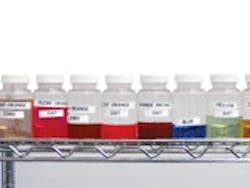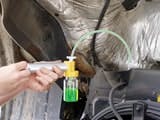How to Get the Most Out of Extended Life Coolants
Extended-life coolants (ELC) have been used in the construction industry for at least a decade, yet misunderstandings and myths still persist in the field. One misunderstanding, according to Elizabeth Nelson, coolant program manager with Polaris Labs, is the idea that you can put ELC in a unit and virtually forget about it.
"You can't do that," Nelson says. "If you do, it's like playing Russian roulette. It doesn't matter what the product is; if you don't pay attention to it, you are going to have a premature engine failure. One of the biggest problems we've had in the field is that people don't pay any attention to the cooling system."
Extended-life coolant is made up of completely different chemistry than conventional coolant, Nelson says. "You are working with a chemical reaction," she says. "It's not like oil where you are working with things like wear metals." Plus, she says, ELC chemistry makes it unnecessary to add supplemental coolant additives (SCA) as may be added in conventional coolants.
"The important thing to remember with ELC is that you still have to monitor the coolants," Nelson says.
Extended-life coolant will last considerably longer in construction applications than conventional coolants. With the use of an extender every 6,000 hours, machines can log 12,000 to 15,000 hours on extended-life coolant, Nelson says. What some fleet managers don't realize, however, is that a machine's mechanical problems, regardless of the coolant product or the formulation, will render the coolant ineffective.
"I'm talking about combustion gas leaks, hot spots in the system, air leaks and electrical ground problems," says Nelson. "Not only can these things lead to premature engine failure, they will destroy your coolant."
Dan Arcy, technical marketing manager for Shell Lubricants, identifies one extended-life coolant myth. "There are a lot of myths out there," he says. "One of them is that ELC and conventional coolants are not compatible and you cannot mix them. Actually you can. If you have extended-life coolant in the machine and you accidentally add a gallon of conventional coolant, say about 10 percent, it's going to be fine. But if you put more in the system, 20 percent for example, then you have to treat the coolant as a conventional coolant. You'll have to add more SCAs."
Mixing the two dilutes the coolant, says Carmen Ulabarro, market development specialist at Chevron Global Products. "With ELC, we recommend no more than 25 percent dilution [with conventional coolant]," she says. "If you go beyond that, then you should maintain the coolant in the system just like it is a conventional coolant and start regular test strip testing and SCA additions." For the full benefits of extended-life coolant, she says, it must be at least 75 percent of what is in the system.
Nelson disagrees about mixing coolants. "We worry about two things," she says. "One, suppose you have an extended-life warranty and the pH is between 8.0 and 9.5, which is normal for ELC. With conventional coolant it takes about 8.5 pH to hold silicate up in solution. If you have an ELC coolant with a pH level down to 8.2, which is fine for ELC, and you mix that with conventional coolant that has higher silicate, you take a chance of knocking the silicates out of solution. They are very dependent on the pH."
The second reason, she says, is that mixing dilutes the carboxylate acids (an organic corrosion inhibitor present as a key component in an additive package). When that happens, she says, the benefits of those acids are negated and the coolant requires treatments as with conventional coolants.
"That is a waste of money," Nelson says. "You're taking higher technology and throwing it out the window."
Extended-life coolant offers many advantages, Ulabarro says. Coolant can last up to 15,000 hours; reduces cooling-system maintenance costs; improves heat transfer compared to silicate-containing coolants; improves water pump life; and offers complete protection of all cooling-system components, including aluminum. More construction fleets are finding that ELC helps their equipment perform better and reduces downtime, she says.
"Construction equipment usually is exposed to potentially hotter conditions than over-the-road trucks, since they are moving much slower and the radiator cooling efficiency may not be there," Ulabarro says. "The no-silicate formulations of ELC help improve heat transfer, help water pumps last longer, and help reduce overall maintenance cost."
But there are disadvantages, she says. One is the lack of end-user understanding of how to maintain the product and, two, dilution beyond the recommended limits due to poor maintenance practices. Outside of those two factors, any piece of equipment in any construction fleet can use and benefit from extended-life coolants, she says.
Although storage of extended-life coolants is almost identical to that of conventional coolants, fleet managers should keep in mind that ELC is ethylene glycol-based, Ulabarro says. Ethylene glycol, in concentrate form, will freeze at 7F. That's not the case with a 50/50 premix.
"If coolant drums are placed outside, they should be placed on their sides," Ulabarro says. "Also, if a coolant is purchased and not used for several months, it is a good idea to agitate the product in case there has been some segregation of the inhibitors. This is much less a problem with ELC-type coolants, but a little bit of agitation is always good."
Extended-life coolants may require less maintenance, but they have to be maintained, Arcy says. "In diesel applications, you should take a sample of coolant every month when you service the vehicle and check it for clarity," he says. "Just hold it up in a clear jar and look through it. If it's clear and bright, you're okay. There shouldn't be any kind of particles floating in it."
The second step, he says, is to take a fractometer and test the freeze point of the coolant. "Basically, a 50-50 mixture gives you a freeze point of -34F. That's all you need to do to maintain ELC."
By comparison, Arcy says, conventional coolants require a sample be pulled, checked visually (it can be green, pink or fuchsia), and the use of a refractometer to check the freeze point. If everything checks out, test strips can be used to determine how much SCA is in the mixture.
Arcy warns against topping off low coolant levels with water. "With a 50/50 mixture, they will pour in a gallon of concentrate coolant and add about the same amount of water," he says. "When that happens, the system gets out of whack over a period of time. That's why you have to check the freeze point: to find out if you are over-concentrated or under-concentrated. You make the adjustments at that time. Making those adjustments probably takes longer than actually doing the test."
Polaris' Nelson recommends having a laboratory evaluate the coolant's pH level at every preventive maintenance check. "You can tell a lot about what's going on with your cooling system by checking ph and glycol levels," she says. "That should be done with ELC as well as conventional coolants."
One of the biggest problems encountered in the field, Nelson says, is the formation of degradation acids. "Fleet managers need to understand that with ELC, you're working with chemical reactions that are taking place due to temperature pressure and flow.
"When temperatures ran at 160 to 180 degrees, you didn't think about the cooling system," she says. "But when engine OEMs started bringing engine temperatures up, and when they climbed to 190 degrees or above, that's when we started seeing chemical reactions taking place. That's why you really need to pay attention to what's going on in the cooling system."
For example, Nelson says, if corrosion sets in and the coolant passages become clogged, "you're going to cavitate and start breaking down the ethylene glycol and that forms acids." The same is true with combustion gas leaks.
Converting a fleet from conventional to extended-life coolant can be done several ways. One way is to do the conversion when equipment comes in for scheduled preventive-maintenance visits. Another is to convert the entire fleet at one time by using coolant extenders.
"When you convert a system, we recommend you completely drain and flush the system, then fill it up with a 50-50 mixture," says Shell's Arcy. "If you don't want to do that, you can use Shell Extended Life Coolant conversion fluid. You pull a sample, look at it to make sure it's clear and bright, use a refractometer and test strips and, if everything is okay, you drain a gallon of coolant from the system. Then you pour in a gallon of the conversion fluid."
Once the extender is poured in, he says, the system goes from a conventional-coolant system to an extended-life system. After the conversion, fleet managers should run the system, get it hot, take a sample, and send it to a lab to confirm the conversion process. Conversion fluids are a particularly good way to go if there is a low-mileage vehicle in the fleet, Arcy says.
Chevron's Ulabarro cautions against gradual fleet conversion. "Having dual coolant inventories only creates confusion and leads to dilution," she says. "I would recommend that the entire fleet be changed if a conversion is going to happen. The best time to do this is when new equipment is coming in that has been ordered with ELC in it."
Extended-life coolants offer many benefits. Equipment managers can reap the rewards of those benefits if they properly understand the coolant's performance and properties.


